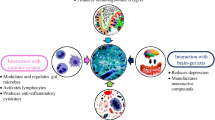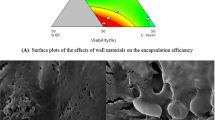Abstract
Incorporation of probiotics into food products serves as a healthy option for delivery of probiotics. Microencapsulation can increase the survival rate of the probiotic bacteria and act as effective mode of administration of the probiotics to the recipients. The aim of this research was to develop a process technology for incorporating microencapsulated probiotics and evaluate the viability of the encapsulated probiotics in biscuits. The microencapsulated probiotics were added in biscuits, to a final concentration of 10 Log CFU/g. Viability above 8 Log CFU/g was found in probiotic biscuit after 8 weeks of storage. This research indicated the feasibility of incorporation of probiotic bacteria into dry matrices in food products and further determines viability of the probiotics during storage to assure probiotic functionality.


Similar content being viewed by others

References
FAO/WHO, Guidelines for the Evaluation of Probiotics in Food. Report of a joint FAO/WHO working group on drafting guidelines for the evaluation of probiotics in foods (FAO/WHO, London, ON, 2002)
Euromonitor International, Cardiovascular Health: A Key Area of Functional Food and Drinks Development (Euromonitor International, London, 2010)
N. Betoret, L. Puente, M.J. Dıaz, M.J. Pagán, M.J. Garcıa, M.L. Gras, J. Martínez-Monzó, P. Fito, Development of probiotic-enriched dried fruits by vacuum impregnation. J. Food Eng. 56, 273–277 (2003)
W. Krasaekoopt, B. Suthanwong, Vacuum impregnation of probiotics in fruit pieces and their survival during refrigerated storage. Kasetsart J. 42, 723–731 (2008)
V.M. Sheehan, P. Ross, G.F. Fitzgerald, Assessing the acid tolerance and the technological robustness of probiotic cultures for fortification in fruit juices. Innov. Food Sci. Emerg. Technol. 8, 279–284 (2007)
S.J. Risch, G. Reineccius, Encapsulation and controlled release of food ingredients, in ACS Symposium Series, American Chemical Society, USA (1995)
A.K. Anal, H. Singh, Recent advances in microencapsulation of probiotics for industrial applications and targeted delivery. Trends Food Sci. Technol. 18(5), 240–251 (2007)
S. Benita, Microencapsulation, Drugs and the Pharmaceutical Science (Marcel Dekker Inc., New York, 1996)
Y. Senuma, C. Lowe, Y. Zweifel, J.G. Hilborn, I. Marison, Alginate hydrogel microspheres and microcapsules prepared by spinning disk atomization. Biotechnol. Bioeng. 67(5), 616–622 (2000)
T.Y. Sheu, R.T. Marshall, Microentrapment of lactobacilli in calcium alginate gels. J. Food Sci. 58(3), 557–561 (1993)
D. Pennacchia, D. Ercolini, G. Blaiotta, O. Pepe, G. Mauriello, F. Villani, Selection of Lactobacillus strains from fermented sausages for their potential use as probiotics. Meat Sci. 67, 309–317 (2004)
H.S. Chung, Y.B. Kim, S.L. Chun, G.E. Ji, Screening and selection of acid and bile resistant Bifidobacteria. Int. J. Food Microbiol. 47(1), 25–32 (1999)
D. Manley, Biscuit, Cracker and Cookie Recipes for the Food Industry (Elsevier, London, 2001)
J. Prasad, H. Gill, J. Smart, P.K. Gopal, Selection and characterization of Lactobacillus and Bifidobacterium strains for use as probiotic. Int. Dairy J. 8, 993–1002 (1998)
A.A. Argyri, G. Zoumpopoulou, K.A.G. Karatzas, E. Tsakalidou, G.J.E. Nychas, E.Z. Panagou, C.C. Tassou, Selection of potential probiotic lactic acid bacteria from fermented olives by in vitro tests. Food microbiol. 33(2), 282–291 (2013)
G.L. Lorca, G.F. de Valdez, Acid tolerance mediated by membrane ATPases in Lactobacillus acidophilus. Biotechnol. Lett. 23, 777–780 (2001)
C.M.C. Chapman, G.R. Gibson, I. Rowland, In vitro evaluation of single-and multi-strain probiotics: inter-species inhibition between probiotic strains, and inhibition of pathogens. Anaerobe 18(4), 405–413 (2012)
H. Jensen, S. Grimmer, K. Naterstad, L. Axelsson, In vitro testing of commercial and potential probiotic lactic acid bacteria. Int. J. Food Microbiol. 153(1), 216–222 (2012)
S.E. Gilliland, D.K. Walker, Factors to consider when selecting a culture of Lactobacillus acidophilus as a dietary adjunct to produce a hypocholesterolemic effect in humans. J. Dairy Sci. 73(4), 905–911 (1990)
M.E. Sanders, Probiotics, Food Technol. 53(11), 67–77 (1999)
G.K. Gbassi, T. Vandamme, S. Ennahar, E. Marchioni, Microencapsulation of Lactobacillus plantarum spp in an alginate matrix coated with whey proteins. Int. J. Food Microbiol. 129(1), 103–105 (2009)
F. Weinbreck, I. Bodnár, M.L. Marco, Can encapsulation lengthen the shelf-life of probiotic bacteria in dry products? Int. J. Food Microbiol. 136(3), 364–367 (2010)
C. Malmo, A. La Storia, G. Mauriello, Microencapsulation of Lactobacillus reuteri DSM 17938 cells coated in alginate beads with chitosan by spray drying to use as a probiotic cell in a chocolate soufflé. Food Bioprocess. Technol. 6(3), 795–805 (2013)
M.A.K. Zanjani, B.G. Tarzi, A. Sharifan, N. Mohammadi, H. Bakhoda, M.M. Madanipour, Microencapsulation of Lactobacillus casei with calcium alginate-resistant starch and evaluation of survival and sensory properties in cream-filled cake. Afr. J. Microbiol. Res. 6, 5511–5517 (2012)
D.Y. Ying et al., Enhanced survival of spray-dried microencapsulated Lactobacillus rhamnosus GG in the presence of glucose. J. Food Eng. 109(3), 597–602 (2012)
L. Yonekura, H. Sun, C. Soukoulis, I. Fisk, Microencapsulation of Lactobacillus acidophilus NCIMB 701748 in matrices containing soluble fibre by spray drying: technological characterization, storage stability and survival after in vitro digestion. J. Funct. Foods 6, 205–214 (2014)
D. Mudgil, S. Barak, B.S. Khatkar, Effect of hydrocolloids on the quality characteristics of tomato ketchup. Carpathian J. Food Sci. Technol. 3(1), 39–43 (2011)
M.A. Luruena-Martınez, A.M. Vivar-Quintana, I. Revilla, Effect of locust bean/xanthan gum addition and replacement of pork fat with olive oil on the quality characteristics of low-fat frankfurters. Meat Sci. 68(3), 383–389 (2004)
Acknowledgements
The authors thank Department of Food Technology, Jamia Hamdard, New Delhi for the facilities and support through the research work.
Author information
Authors and Affiliations
Corresponding author
Rights and permissions
About this article
Cite this article
Muzzafar, A., Sharma, V. Microencapsulation of probiotics for incorporation in cream biscuits. Food Measure 12, 2193–2201 (2018). https://doi.org/10.1007/s11694-018-9835-z
Received:
Accepted:
Published:
Issue Date:
DOI: https://doi.org/10.1007/s11694-018-9835-z



